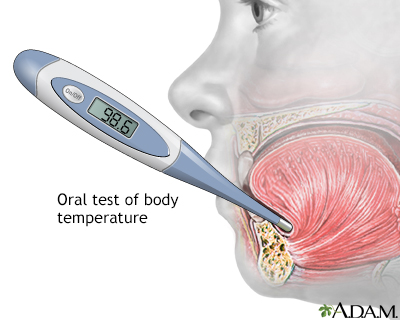Q fever
Query fever
Q fever is an infectious disease caused by bacteria spread by domestic and wild animals and ticks.
Images

Causes
Q fever is caused by the bacteria Coxiella burnetii, which live in domestic animals such as cattle, sheep, goats, birds, and cats. Some wild animals and ticks also carry these bacteria.
You can get Q fever by drinking raw (unpasteurized) milk, or after breathing in dust or droplets in the air that are contaminated with infected animal feces, blood, or birth products.
People at risk for infection include slaughterhouse workers, veterinarians, researchers, food processors, and sheep and cattle workers. Men are infected more often than women. Most people who get Q fever are age 30 to 70 years.
In rare cases, the disease affects children, especially those who live on a farm. In infected children younger than 3 years old, Q fever is usually noticed while looking for the cause of pneumonia.
Symptoms
Symptoms usually develop 2 to 3 weeks after coming in contact with the bacteria. This time is called the incubation period. Most people have no symptoms. Others may have moderate symptoms similar to the flu. If symptoms occur, they may last for several weeks.
Common symptoms may include:
- Dry cough (nonproductive)
- Fever
- Headache
- Joint pain (arthralgia)
- Muscle pains
Other symptoms that may develop include:
- Abdominal pain
- Chest pain
- Jaundice (yellowing of the skin and whites of the eyes)
- Rash
Exams and Tests
A physical exam may reveal abnormal sounds (crackles) in the lungs or an enlarged liver or spleen. In the late stages of the disease, a heart murmur may be heard.
Tests that may be done include:
- A chest x-ray to detect pneumonia or other changes in the lungs
- Blood tests to check for antibodies to Coxiella burnetti
- Liver function test
- Complete blood count (CBC) with differential
- Tissue staining of infected tissues to identify the bacteria
- Electrocardiogram (ECG) or echocardiogram (echo) to look at the heart for damage caused by the Coxiella burnetti bacteria
Treatment
Treatment with antibiotics can shorten the length of the illness. Antibiotics that are commonly used include tetracycline and doxycycline. Pregnant women or children who still have any baby teeth should avoid tetracycline by mouth because it can permanently discolor growing teeth.
Outlook (Prognosis)
Most people get better with treatment. However, complications can be very serious and sometimes even life threatening. Q fever should always be treated if it causes symptoms.
Possible Complications
In rare cases, Q fever causes a heart infection (endocarditis) that can lead to severe symptoms or even death if untreated. Other complications can include:
- Bone infection (osteomyelitis)
- Brain infection (encephalitis)
- Liver infection (chronic hepatitis)
- Lung infection (pneumonia)
When to Contact a Medical Professional
Contact your health care provider if you develop symptoms of Q fever. Also contact your provider if you have been treated for Q fever and symptoms return or new symptoms develop.
Prevention
Pasteurization of milk destroys the bacteria that cause early Q fever. Domestic animals should be inspected for signs of Q fever if people exposed to them have developed symptoms of the disease.
Related Information
Tick biteFlu
Community-acquired pneumonia in adults
Endocarditis
Encephalitis
Osteomyelitis
References
Fournier P-E, Raoult D. Rickettsial infectionss. In: Goldman L, Cooney KA, eds. Goldman-Cecil Medicine. 27th ed. Philadelphia, PA: Elsevier; 2024:chap 302.
Hartzell JD, Marrie TJ, Raoult D. Coxiella burnetti (Q fever). In: Bennett JE, Dolin R, Blaser MJ, eds. Mandell, Douglas, and Bennett's Principles and Practice of Infectious Diseases. 9th ed. Philadelphia, PA: Elsevier; 2020:chap 188.
BACK TO TOPReview Date: 8/29/2024
Reviewed By: Jatin M. Vyas, MD, PhD, Professor in Medicine, Harvard Medical School; Associate in Medicine, Division of Infectious Disease, Department of Medicine, Massachusetts General Hospital, Boston, MA. Also reviewed by David C. Dugdale, MD, Medical Director, Brenda Conaway, Editorial Director, and the A.D.A.M. Editorial team.

Health Content Provider
06/01/2025
|
A.D.A.M., Inc. is accredited by URAC, for Health Content Provider (www.urac.org). URAC's accreditation program is an independent audit to verify that A.D.A.M. follows rigorous standards of quality and accountability. A.D.A.M. is among the first to achieve this important distinction for online health information and services. Learn more about A.D.A.M.'s editorial policy, editorial process and privacy policy. A.D.A.M. is also a founding member of Hi-Ethics. This site complied with the HONcode standard for trustworthy health information from 1995 to 2022, after which HON (Health On the Net, a not-for-profit organization that promoted transparent and reliable health information online) was discontinued. |
The information provided herein should not be used during any medical emergency or for the diagnosis or treatment of any medical condition. A licensed medical professional should be consulted for diagnosis and treatment of any and all medical conditions. Links to other sites are provided for information only -- they do not constitute endorsements of those other sites. © 1997- 2025 A.D.A.M., a business unit of Ebix, Inc. Any duplication or distribution of the information contained herein is strictly prohibited.
